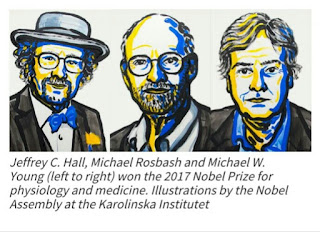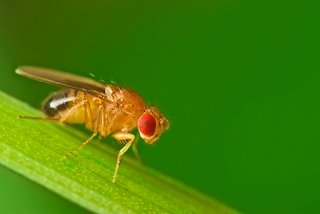Thanks in part to their discoveries, scientists and doctors now know these day-and-night cycles keep creatures alive by regulating our alertness, sleep patterns, blood pressure, hormones, body temperature and when we eat.
Our circadian clock helps to regulate sleep patterns, feeding behavior, hormone release, blood pressure and body temperature. A large proportion of our genes are regulated by the clock. Illustration by Jeffrey C. Hall, Michael Rosbash and Michael W. Young (left to right) won the 2017 Nobel Prize for physiology and medicine. Illustrations by the Nobel Assembly at the Karolinska Institutet
Who are the winners: All three recipients are Americans who made their Nobel prize-winning discoveries by working with fruit flies, a popular animal model for neurobiology and genetics experiments.
Jeffrey C. Hall, 72, is currently a geneticist at the University of Maine, but conducted his groundbreaking work with biologist Michael Rosbash, 73, at Brandeis University near Boston. In the 1980s, the pair collaborated with geneticist Michael W. Young, 68, of Rockefeller University in New York to characterize what are known as the “period” and “timeless” genes.
A decade earlier, geneticists Seymour Benzer and Ronald Konopka had discovered that mutations of the period gene disrupted the cycle of regular movements and egg hatching that fruit flies normally go through during a 24-hour period. Some flies went through their activities on shortened, nine-hour loops, while the schedule for others lengthened to 28 hours.
Hall, Rosbash and Young wound up pinpointing the location of the period and timeless genes within the fruit fly genome and working out what their proteins do. (Reminder: Genes located on our DNA make proteins. Proteins make up our cells, our bodies and everything we do).
What they did: Scientists had known about circadian rhythms since 1729, when astronomer Jean Jacques d’Ortous de Mairan placed a mimosa plant into a dark room and noticed that the plant’s leaves still opened and closed at the same times every day.
Through a series of breakthroughs, Hall, Rosbash and Young showed these internal clocks are self-regulated. In the morning, sunlights switches on the “period” gene, which begins to produce its protein. This protein accumulates in the cytoplasm, the chunky space in our cells that surrounds the nucleus where our DNA and the period gene are housed.
When the period gene is active, period (PER) messenger RNA is made. This messenger RNA is transported to the cell’s cytoplasm and serves as template for the production of PER protein. The PER protein accumulates in the cell’s nucleus, where the period gene activity is blocked. This gives rise to the inhibitory feedback mechanism that underlies a circadian rhythm. Illustration by the Nobel Assembly at the Karolinska Institutet..
Hall and Rosbash found that period proteins built up throughout the day until nightfall, when their levels began to gradually drop. When dawn broke, period proteins disappeared, and the cycle repeated itself. They hypothesized that the period protein was somehow crossing into the nucleus to shut off its own gene, in what they dubbed a transcription-translation feedback loop.
Young extended the work by uncovering two additional protein, named “timeless,” which was responsible to escorting the period protein into the nucleus. Young’s lab also identified a third protein — called doubletime — that controlled the timing of the destruction of the period proteins.
Why it matters: Their combined work launched a subgenre of molecular biology that focused on circadian rhythm proteins. Though the genes differ from species to species, transcription-translation feedback networks for circadian rhythms were ultimately found in a bevy of organisms — from algae to plants to Homo sapiens.
In humans, these clock genes control the production of insulin and other hormones involved in maintaining how our bodies process food. Disruption of the genes through sleep deprivation or mutation alters brain functions and has been tied to sleep disorders, depression, bipolar disorder and memory defects. Out of whack circadian rhythms also increase a person’s risk for cancer, obesity, diabetes and other metabolic disorders.














No comments:
Post a Comment